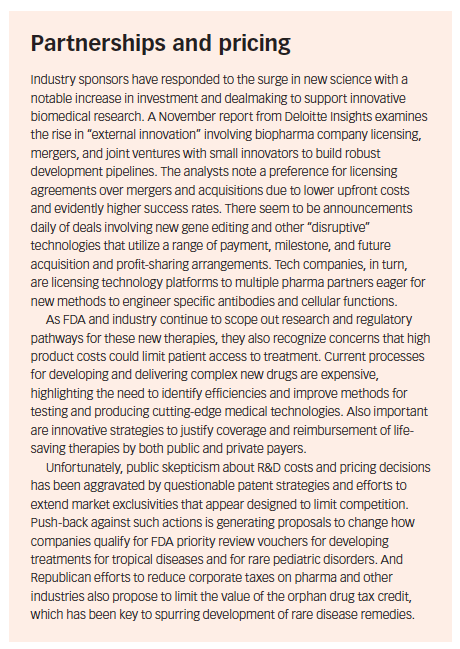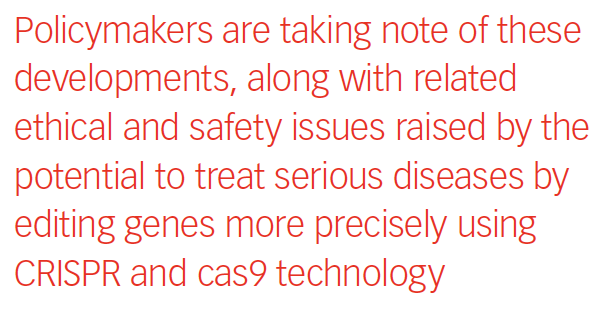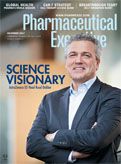A Year of Transformation for Science & Medicine
In 2017, patients gained access to the first gene therapies and more orphan and breakthrough drugs.
In recent months, biopharma companies won FDA approval of several truly breakthrough drugs that modify human cells to treat and potentially cure deadly disorders, and more are on the way. Novartis led with CAR-T therapy Kymriah for patients with relapsed acute lymphoblastic leukemia, followed by Yescarta from Gilead’s Kite Pharma for a similar condition. Spark Therapeutics’ Luxturna promises to cure a rare genetic
Jill Wechsler

eye disorder that causes blindness.
Related discoveries are spurring development of antisense drugs and RNA treatments that can modulate immune pathways, such as Biogen’s Spinraza (nusinersen), approved a year ago as the first treatment for spinal muscular atrophy, which is often fatal for infants. And researchers reported success last month in utilizing gene therapy to create healthy skin to treat a life-threatening genetic skin-blistering disorder, raising expectations that genetically modified skin may treat open wounds and related conditions.
FDA reports that some 40 companies are developing CAR-T technologies for multiple indications and that it is monitoring more than 600 active investigational new drug applications (INDs) related to gene and cellular therapies. Scientists also are optimistic about developing vaccines to prevent and treat chronic illnesses as well as infectious diseases such as malaria and AIDS. A new report from the Pharmaceutical Research and Manufacturers of America (PhRMA) cites more than 100 vaccines in development to prevent cancer, HIV, allergies, and other serious conditions.
Regulators encouraging
FDA support for biomedical innovation is a prominent theme in these discussions, and one championed by Commissioner Scott Gottlieb. Since taking the helm of the agency in May, Gottlieb has rolled out multiple initiatives to bolster biomedical R&D, demonstrating in the process that FDA does not impede approval of new life-saving therapies for patients. Priority efforts are to speed up orphan drug designations, spur development of complex generic drugs, streamline clinical trials through expanded modeling and simulation, and help patients gain early access to experimental therapies for serious conditions.

Digital health also is a prime FDA challenge, with Gottlieb unveiling an R&D plan last June to encourage new device and software development. In September, FDA approved the first mobile medical application to help treat substance use disorders, and last month the first digital pill came to market, a version of antipsychotic drug Abilify from Otsuka Pharmaceutical. It contains a tiny chip able to send a signal to an adhesive patch that informs a smart phone when the pill is ingested.
FDA’s new Oncology Center of Excellence (OCE), formally established in January 2017, is facilitating approval of dozens of new cancer therapies and additional indications. The latest challenge is developing drugs for patients with certain cancer biomarkers, as opposed to disease affecting specific body organs, as seen in the recent approval of an added indication for Merck & Co.’s Keytruda based on this technology.
The 21st Century Cures legislation approved at the end of 2016 supports many of these initiatives, plus a new program for developing regenerative medicine advanced therapies (RMAT). The new Office of Tissues and Advanced Therapies (OTAT) in the Center for Biologics Evaluation and Research (CBER) has established a process for designating and overseeing RMATs, including gene and cellular therapies that fall under this umbrella. Last month, FDA unveiled a RMAT regulatory framework with guidances for expediting development and review of these promising treatments.
Additional resources provided by the FDA Reauthorization Act (FDARA) fund many of the initiatives for spurring development and efficient oversight of cutting-edge therapies. Of particular note is the expansion of FDA’s Office for Combination Products (OCP), which advises sponsors on whether a new combination therapy should be regulated as a drug, biologic, or device. This process increasingly involves gene and other advanced therapies that incorporate prefilled syringes or autoinjectors to deliver treatment. OCP’s staff faces a growing volume of queries on combo product development programs, along with commitments to update guidances and prepare additional advisories on labeling issues and bridging studies, among others.
Although the long-term effects of new gene and cellular therapies are unknown, these initial successes have spurred optimism about further development of treatments for both rare and more prevalent serious conditions, particularly neurological diseases such as ALS, Alzheimer’s, and Huntington’s disease. At the same time, safety issues have sidelined some promising therapies, such as a CAR-T candidate from June Therapeutics that was linked to severe brain toxicity that led to patient deaths in clinical trials.
Policymakers are taking note of these developments, along with related ethical and safety issues raised by the potential to treat serious diseases by editing genes more precisely using CRISPR and cas9 technology. A hearing before the Senate Health, Education, Labor and Pensions (HELP) Committee last month addressed

the possibilities for preventing conditions such as sickle cell disease and blood disorders and the need for appropriate regulatory oversight of technologies able to change the human genome or to develop biological weapons. Experts agreed that the current FDA regulatory framework, plus oversight by the HHS Recombinant DNA Advisory Committee and institutional review boards (IRBs), can adequately assess the science and ethics of genome editing, and that stricter rules might discourage research or shift it overseas.
Sponsors and researchers also recognize the need to better understand which individuals face higher risks from new gene therapies and the potential for severe side effects. But with R&D pipelines full of innovative drugs, the future looks promising for continuing gains in discovering important new treatments for life-threatening diseases.
Jill Wechsler is Pharmaceutical Executive’s Washington Correspondent. She can be reached at jllwechsler7@gmail.com

Pfizer, GSK Gain ACIP Recommendations for RSV and Meningococcal Vaccines
April 18th 2025The Centers for Disease Control and Prevention’s Advisory Committee on Immunization Practices voted to expand access to Pfizer’s respiratory syncytial virus vaccine Abrysvo for high-risk adults in their 50s and voted in favor of GSK’s meningococcal vaccine, Penmenvy, for streamlined adolescent protection.
Navigating Distrust: Pharma in the Age of Social Media
February 18th 2025Ian Baer, Founder and CEO of Sooth, discusses how the growing distrust in social media will impact industry marketing strategies and the relationships between pharmaceutical companies and the patients they aim to serve. He also explains dark social, how to combat misinformation, closing the trust gap, and more.